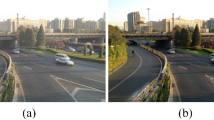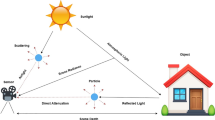Abstract
In this paper, we propose an image dehazing model based on the generative adversarial networks (GAN). The pix2pix framework is taken as the starting point in the proposed model. First, a UNet-like network is employed as the dehazing network in view of the high consistency of the image dehazing problem. In the proposed model, a shortcut module is proposed to effectively increase the nonlinear characteristics of the network, which is beneficial for subsequent processes of image generation and stabilizing the training process of the GAN network. Also, inspired by the face illumination processing model and the perceptual loss model, the quality vision loss strategy is designed to obtain a better visual quality of the dehazed image, based on peak signal-to-noise ratio (PSNR), structural similarity (SSIM) and perceptual losses. The experimental results on public datasets show that our network demonstrates the superiority over the compared models on indoor images. Also, the dehazed image by the proposed model shows better chromaticity and qualitative quality.













Similar content being viewed by others
References
Agarwal, T.K., Tiwari, M., Lamba, S.S.: Modified histogram based contrast enhancement using homomorphic filtering for medical images. In: 2014 IEEE International Advance Computing Conference (IACC), pp. 964–968
Akbarizadeh, G.: A new statistical-based kurtosis wavelet energy feature for texture recognition of SAR images. IEEE Trans. Geosci. Remote Sens. 50(11), 4358–4368 (2012)
Cai, B., Xu, X., Jia, K., Qing, C., Tao, D.: Dehazenet: An end-to-end system for single image haze removal. IEEE Trans. Image Process. 25(11), 5187–5198 (2016)
Chen, D., He, M., Fan, Q., Liao, J., Zhang, L., Hou, D., Yuan, L., Hua, G.: Gated context aggregation network for image dehazing and deraining. In: 2019 IEEE Winter Conference on Applications of Computer Vision (WACV), pp. 1375–1383
Davari, N., Akbarizadeh, G., Mashhour, E.: Intelligent diagnosis of incipient fault in power distribution lines based on corona detection in uv-visible videos. IEEE Trans. Power Deliv. (2020)
Dong, H., Pan, J., Xiang, L., Hu, Z., Zhang, X., Wang, F., Yang, M.H.: Multi-scale boosted dehazing network with dense feature fusion. In: 2020 IEEE/CVF Conference on Computer Vision and Pattern Recognition (CVPR), pp. 2154–2164
Dong, Y., Liu, Y., Zhang, H., Chen, S., Qiao, Y.: Fd-gan: Generative adversarial networks with fusion-discriminator for single image dehazing. Proc. AAAI Conf. Artif. Intell. 34, 10729–10736 (2020)
Fu, X., Wang, J., Zeng, D., Huang, Y., Ding, X.: Remote sensing image enhancement using regularized-histogram equalization and DCT. IEEE Geosci. Remote Sens. Lett. 12(11), 2301–2305 (2015)
Gu, Y., Yang, X., Gao, Y.: A novel total generalized variation model for image dehazing. J. Math. Imaging Vis. 61(9), 1329–1341 (2019)
He, K., Sun, J., Tang, X.: Single image haze removal using dark channel prior. IEEE Trans. Pattern Anal. Mach. Intell. 33(12), 2341–2353 (2011)
He, K., Zhang, X., Ren, S., Sun, J.: Deep residual learning for image recognition. In: Proceedings of the IEEE Conference on Computer Vision and Pattern Recognition, pp. 770–778
Huang, G., Liu, Z., Van Der Maaten, L., Weinberger, K.Q.: Densely connected convolutional networks. In: 2017 IEEE Conference on Computer Vision and Pattern Recognition (CVPR), pp. 4700–4708
Im, J., Yoon, I., Hayes, M.H., Paik, J.: Dark channel prior-based spatially adaptive contrast enhancement for back lighting compensation. In: 2013 IEEE International Conference on Acoustics, Speech and Signal Processing, pp. 2464–2468
Isola, P., Zhu, J., Zhou, T., Efros, A.A.: Image-to-image translation with conditional adversarial networks. In: 2017 IEEE Conference on Computer Vision and Pattern Recognition (CVPR), pp. 5967–5976
Jobson, D.J., Rahman, Zu., Woodell, G.A.: A multiscale retinex for bridging the gap between color images and the human observation of scenes. IEEE Trans. Image Process. 6(7), 965–976 (1997)
Johnson, J., Alahi, A., Fei-Fei, L.: Perceptual losses for real-time style transfer and super-resolution. In: Leibe B, Matas J, Sebe N, Welling M (eds) Computer Vision—ECCV 2016, pp. 694–711 (2016)
Kim, Joung-Youn., Kim, Lee-Sup., Hwang, Seung-Ho.: An advanced contrast enhancement using partially overlapped sub-block histogram equalization. IEEE Trans. Circuits Syst. Video Technol. 11(4), 475–484 (2001)
Krizhevsky, A., Sutskever, I., Hinton, G.: Imagenet classification with deep convolutional neural networks. Adv. Neural Inf. Process. Syst. 25
Land, E.H., McCann, J.J.: Lightness and retinex theory. Josa 61(1), 1–11 (1971)
Ledig, C., Theis, L., Huszár, F., Caballero, J., Cunningham, A., Acosta, A., Aitken, A., Tejani, A., Totz, J., Wang, Z., et al.: Photo-realistic single image super-resolution using a generative adversarial network. In: 2017 IEEE Conference on Computer Vision and Pattern Recognition (CVPR), pp. 105–114
Li, B., Peng, X., Wang, Z., Xu, J., Feng, D.: Aod-net: All-in-one dehazing network. In: 2017IEEE International Conference on Computer Vision (ICCV), pp. 4780–4788
Li, R., Pan, J., Li, Z., Tang, J.: Single image dehazing via conditional generative adversarial network. In: 2018 IEEE/CVF Conference on Computer Vision and Pattern Recognition (CVPR), pp. 8202–8211
LI, Tl., XIAO, J., ZHAI, Dh.: Traffic image de-haze algorithm based on adaptive parameter size. J. Southwest Univ. Sci. Technol. p 04 (2014)
Lim, S.H., Mat Isa, N.A., Ooi, C.H., Toh, K.K.V.: A new histogram equalization method for digital image enhancement and brightness preservation. Signal Image Video Process. 9(3), 675–689 (2015)
Liu, W., Liu, X., Ma, H., Cheng, P.: Beyond human-level license plate super-resolution with progressive vehicle search and domain priori gan. In: Proceedings of the 25th ACM international conference on Multimedia, pp. 1618–1626 (2017)
Liu, X., Liu, W., Mei, T., Ma, H.: Provid: progressive and multimodal vehicle reidentification for large-scale urban surveillance. IEEE Trans. Multimed. 20(3), 645–658 (2017b)
Liu, X., Ma, Y., Shi, Z., Chen, J.: Griddehazenet: Attention-based multi-scale network for image dehazing. In: Proceedings of the IEEE/CVF International Conference on Computer Vision, pp. 7314–7323
Liu, X., Zhang, M., Liu, W., Song, J., Mei, T.: Braidnet: Braiding semantics and details for accurate human parsing. In: Proceedings of the 27th ACM International Conference on Multimedia, pp. 338–346
Ma, W., Xie, X., Yin, C., Lai, J.: Face image illumination processing based on generative adversarial nets. In: 2018 24th International Conference on Pattern Recognition (ICPR), pp. 2558–2563 (2018)
Mei, K., Jiang, A., Li, J., Mingwen, W.: Progressive feature fusion network for realistic image dehazing. In: Asian Conference on Computer Vision, pp. 203–215
Okuno, T., Nishitani, T.: Efficient multi-scale retinex algorithm using multi-rate image processing. In: 2009 16th IEEE International Conference on Image Processing (ICIP), pp. 3145–3148 (2009)
Qin, X., Wang, Z., Bai, Y., Xie, X., Jia, H.: Ffa-net: feature fusion attention network for single image dehazing. Proc. AAAI Conf. Artif. Intell. 34, 11908–11915 (2020)
Qu, Y., Chen, Y., Huang, J., Xie, Y.: Enhanced pix2pix dehazing network. In: 2019 IEEE/CVF Conference on Computer Vision and Pattern Recognition (CVPR), pp. 8152–8160 (2019)
Rahman, Zu., Jobson, D.J., Woodell, G.A.: Retinex processing for automatic image enhancement. J. Electron. Imaging 13(1), 100–110 (2004)
Ren, W., Liu, S., Zhang, H., Pan, J., Cao, X., Yang, M.H.: Single image dehazing via multi-scale convolutional neural networks. Comput. Vis. ECCV 2016, 154–169 (2016)
Romano, Y., Elad, M.: Sos boosting of image denoising algorithms. arXiv:1502.06220 (2015)
Ronneberger, O., Fischer, P., Brox, T.: U-net: Convolutional networks for biomedical image segmentation. In: Navab, N., Hornegger, J., Wells, W.M., Frangi, A.F. (eds) Medical Image Computing and Computer-Assisted Intervention – MICCAI 2015, pp. 234–241 (2015)
Santra, S., Mondal, R., Chanda, B.: Learning a patch quality comparator for single image dehazing. IEEE Trans. Image Process. 27(9), 4598–4607 (2018)
Singh, K., Kapoor, R.: Image enhancement using exposure based sub image histogram equalization. Pattern Recognit. Lett. 36, 10–14 (2014)
Singh, K., Kapoor, R., Sinha, S.K.: Enhancement of low exposure images via recursive histogram equalization algorithms. Optik Int. J. Light Electron Opt. 126(20), 2619–2625 (2015)
Sreenivasan, K., Havlicek, M., Deshpande, G.: Non-parametric hemodynamic deconvolution of FMRI using homomorphic filtering. IEEE Trans Med. Imaging 34(5), 1155–1163 (2014)
Tang, K., Yang, J., Wang, J.: Investigating haze-relevant features in a learning framework for image dehazing. In: 2014 IEEE Conference on Computer Vision and Pattern Recognition (CVPR), pp. 2995–3002 (2014)
Tirandaz, Z., Akbarizadeh, G.: A two-phase algorithm based on kurtosis curvelet energy and unsupervised spectral regression for segmentation of SAR images. IEEE J. Select. Top. Appl. Earth Observ. Remote Sens. 9(3), 1244–1264 (2015)
Tirandaz, Z., Akbarizadeh, G., Kaabi, H.: Polsar image segmentation based on feature extraction and data compression using weighted neighborhood filter bank and hidden markov random field-expectation maximization. Measurement 153, 107432 (2020)
Ulyanov, D., Vedaldi, A., Lempitsky, VS.: Instance normalization: the missing ingredient for fast stylization. CoRR abs/1607.08022, arXiv:1607.08022 (2016)
Wu, S., Hu, Z., Yu, W., Feng, J.: An improved image enhancement approach based on retinex theory. In: 2013 International Conference on Information Technology and Applications, pp. 67–71 (2013)
Xiao, L., Li, C., Wu, Z., Wang, T.: An enhancement method for X-ray image via fuzzy noise removal and homomorphic filtering. Neurocomputing 195, 56–64 (2016)
Yang, D., Sun, J.: Proximal dehaze-net: A prior learning-based deep network for single image dehazing. In: Ferrari, V., Hebert, M., Sminchisescu, C., Weiss, Y. (eds) Computer Vision—ECCV 2018, pp. 729–746 (2018)
Zalpour, M., Akbarizadeh, G., Alaei-Sheini, N.: A new approach for oil tank detection using deep learning features with control false alarm rate in high-resolution satellite imagery. Int. J. Remote Sens. 41(6), 2239–2262 (2020)
Zhang, H., Patel, V.M.: Densely connected pyramid dehazing network. In: 2018 IEEE/CVF Conference on Computer Vision and Pattern Recognition (CVPR), pp. 3194–3203 (2018)
Zhang, H., Sindagi, V., Patel, V.M.: Joint transmission map estimation and dehazing using deep networks. IEEE Trans. Circuits Syst. Video Technol. 30(7), 1975–1986 (2020)
Zhang, X.C., Jin, X.D.: Computer vision and digital image processing in intelligent navigation system. Appl. Mech. Mater. 687, 3828–3831 (2014)
Acknowledgements
This work was supported in part by National Natural Science Foundation of China (Grant No.617 03337), and by Aviation Science Foundation of China (Grant No.ASFC-20191053002).
Author information
Authors and Affiliations
Corresponding author
Ethics declarations
Conflict of interest
We have no conflict of interest.
Additional information
Publisher's Note
Springer Nature remains neutral with regard to jurisdictional claims in published maps and institutional affiliations.
Rights and permissions
About this article
Cite this article
Li, S., Lin, J., Yang, X. et al. BPFD-Net: enhanced dehazing model based on Pix2pix framework for single image. Machine Vision and Applications 32, 124 (2021). https://doi.org/10.1007/s00138-021-01248-9
Received:
Revised:
Accepted:
Published:
DOI: https://doi.org/10.1007/s00138-021-01248-9




